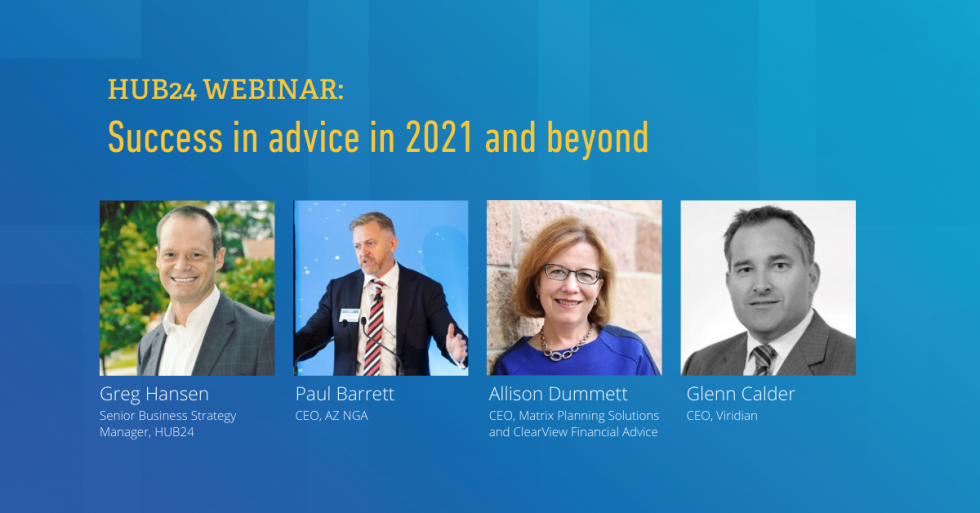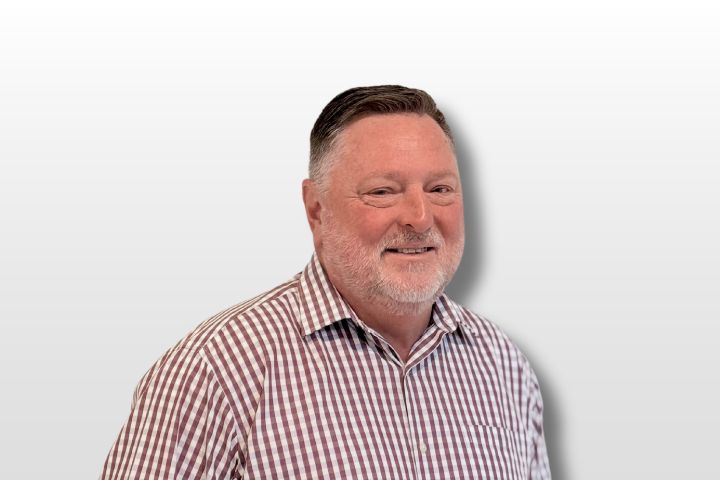Part 2 – Digital connectivity, big bang tech solutions and the revenue sweet spot
In Part 2 of our transcript from our recent webinar session with HUB24’s Senior Business Strategy Manager Greg Hansen, leaders of change in the advice industry – AZ NGA CEO Paul Barrett, Viridian CEO Glenn Calder and Matrix Planning Solutions and ClearView Financial Advice CEO Allison Dummett – discuss how they are working with practices and advisers to encourage entrepreneurialism, challenge profitability, achieve digital connectivity and collaborate to advance advice.
Greg Hansen (GH) – Can you tell me a bit about your businesses?
Allison Dummett (AD) – I am the CEO of two licensees – Clearview Financial Advice and Matrix Planning Solutions – different brands, but behind the scenes it’s one kitchen with many restaurants and one back office. We primarily work with self-employed advisers – all up we have around 200 or so advisers across Australia.
Glenn Calder (GC) – Viridian Advisory formed in 2015. We just wanted to do things a little bit differently after coming out of major institutions. Our model is around promoting everyone to share ownership. We run two licenses as well – Viridian Advisory License is a self-employed channel and Viridian Select for self-employed advisers who are culturally aligned with where we are heading, which is around the future direction of the industry.
Paul Barrett (PB) – ANZ NA formed six years ago. We are an investor in professional advisory services SMEs, so accounting firms, financial planning firms and other financial service companies. What we try and do is help those firms use capital and debt to grow. We have a succession solution and a whole lot of other solutions for those firms to access.
GH – What are your thoughts on digital connectivity?
GC – I think digital connectivity is the secret key in unlocking the future to pretty much everything here. It’s hard to investigate new technologies in our industry because to develop it yourself takes a huge number of resources, time and development capability, so you have to be a price taker or an information technology taker.
One of the biggest fears I have is that our industry could be absolutely smashed in an instant if someone like Apple or Google sent their smartest Harvard graduates over here to learn financial services law and then write code for an app that provides real-time financial advice at a personal level, but which we haven’t been able to crack.
To me, digital connectivity is the key for driving down the cost of providing financial advice, real-time compliance and efficiencies. All our clients have had five Zoom calls now, so you’re a business it’s absolutely going to be the future and we are either going to be a taker of those services or we are going to start to band together for a shared vision and advice delivery.
The worst words that we can hear come out of the mouths of one of our best clients is, “My daughter has just started work, can you help me set up a superannuation fund?” For us to provide advice with $8000 saved up, our cost to serve is $3000, how could we provide that? If you are providing lip service or you’re doing people a favour, it’s not a true business relationship. But if we had a digital delivery and connectivity mechanism for that type of client to stay connected into our business, then we could say at a business level, “Oh they have a pay rise? Maybe it’s time for a call…or maybe they are up for some other services?”
GH – Is there some scope to work together on technology and digital connectivity?
AD – I think if we want clients to get the benefit of our professional experience, all the good things that come out of having advice, then the advice businesses have to drive the improvements in technology. You mention Google and Amazon, but it’s equally as possible that we see other players that will build that kind of technology, so it’s almost a conveyor belt of solutions. And in some ways, we have seen that in the States, so it’s important we get together as a profession to drive innovation in advice technology.
Further to that, one of the biggest issues for practices that I talk to is the adviser with the entrepreneurial spirit, who’s got the great technical skills, but they are being pulled back into having to manage a lot of tasks on a day-to-day basis. We are constantly challenging our suppliers with “How do we automate? How do we get some of the detailed grunt work automated so that a less expensive resource can do that work?”
PB – When it comes to this whole topic of data and technology, I feel like we almost need to set the scene. Are we talking big bang technology that is going to be expensive, take 10 years to implement and be amazing? Or is it small and incremental technology? I think often we fall into the trap on this discussion trying to imagine the big bang solution to our efficiency and data problems. If we wait for the Apples and whoever else, we’ll never get there.
As a business owner and someone who is involved in the ownership of financial planning and accounting firms, we spend more time thinking about the smaller incremental gains we can make out of technology. I can tell you now, a business owner doesn’t have five or ten years to wait for the big solution that we are all trying to find or participate in and there are technology systems out there today that you can buy off the shelf that are awesome, game changing solutions. I will give you one example, one we have just put in here actually, which is Trello. We learned about Trello from watching one of our firms put it in place, they put it in place in a month and it totally changed their approach to the client, to the way they manage and hunt as a pack when it comes to the client. So, you have got these rent roll, property, accounting, tax, planners all working on this one client file sitting on this Trello and it’s firing off workflow and emails and task management in real time. This stuff works.
The other thing is: a focus on processes is worth prioritising over technology. Often when you go into the detail and go in with a manufacturer’s lens to a planning firm, you will see huge inefficiencies in processes. There are tasks that each person is performing in that business, the duplication, the complexity, and the overwork is incredible. We start there with a practice. We do time and motion studies, looking at the minutes taken per task over all the tasks and then we put in simple workflows, using your Xplan automations to try and get some consistency with that task management and that has this huge efficiency dividend.
The bit that we started talking about was where you have a firm with accountants and planners working together: the sharing of client data real time to enable the other professional to be a Johnny-on-the-spot solution at the time the client wants it–that’s what we want to get to.
GH – A lot of what we’ve discussed on technology and process automation is driven by cost to serve. Allison, I know you have been doing some research and thinking on this. Can you share that with us?
AD –We have just been through a comprehensive ‘cost to serve’ exercise with every single practice to help practices get a deep understanding of what it is costing to provide the services they offer. And what I find is once they look at this, so many epiphanies happen, one of which is, “I am giving away my services too cheaply”, but another is, “I am spending time on things that aren’t of value to my clients.” And that’s fundamentally wrong. So that realisation of how much services are costing and the realisation that if you can delegate to a less expensive resource or automate you can get that cost out of what you are providing to a client is really critical. So, I think it’s time we changed the dialogue from what is the price people have been quoting clients to what is the actual cost to provide those services.
I had a conversation with an adviser where his big realisation from that exercise was that he had to reinforce the value of his services with his clients and connect that to the costs of running a professional advice practice, and the benefits they get from that. The response from clients has been phenomenal, but it started with having that deep understanding of what it was costing him.
For others we worked with, the realisation was along the lines of ‘If I don’t charge appropriately, I am doing myself out of value, but I am also doing my shareholders and my family out of value.’.
GC – Just wondering if you have done a deep dive on that – what would you say is the average cost to serve in your business and what would you say are the differences between those who have got the efficiencies right and those that that haven’t?
AD – On average, we found costs hovered around $3,300 to provide ongoing service to a client with limited complexity including a profit margin. That led to related questions like, “How are they (advisers) going to find efficiencies, so that they can get the price down and improve the profit margin?” – that is one challenge they (advisers) are dealing with.
Another one is capacity – for some practices, when they go through the detailed analysis, they are discovering that they need more staff or advisers to get the result they need in that business and they are squeezing things too thin. With larger practices, if you get some scale in a business, you are able to get efficiencies and are therefore able to give your clients a more sharply priced service.
PB – This is a fascinating topic. If someone were going to look at it more from a business lens, I would say financially successful businesses we have invested in have EBIT margins of 55% and the lowest is probably 12% and you have everyone in between and we try and understand what they all are doing differently. Ones that are at the top of that EBIT curve, they have a very clear value proposition, a very clear client strategy and what they are trying to take to the client is very clear. And they are passionate believers in what they take to the client. With that approach, everything else seems to fall into line. It’s the ones at the bottom end of that (the EBIT margins) who are a bit confused–they have too many people with their own value propositions for the client, pod structures, decentralisation, and it’s all a bit mushy.
There’s a bit of a paradox here because there is a scale trap as well, we find. Those firms with the higher EBIT ratios aren’t the biggest firms. They are probably the medium-sized firms. Analysis shows us that once the wage bill got above $1.7 million, the EBIT margin started to decline really quickly and we wanted to understand why. We realised these firms get to medium size and their EBIT margins get to 50% and they keep growing and they throw more people into the mix and people bring other ways of doing things from other firms, bring other spreadsheets, bring other processes. What happens is the medium firm goes from being one medium firm where the CEO is in control to a collection of small firms where there’s decentralised pods with great inefficiencies. The challenge we have is: as we grow our firms, how do we avoid falling into that scale trap? I think the answer lies in that conversation around how we use a bit of tech and the process of engineering as well as people to sustain growth.
GC – That is a really interesting concept because I would have said four or five years ago, we were on the upper end of that sort of profitability margin and now we have probably changed our view a little bit. I reckon around about 35% revenue is almost the sweet spot. If we actually got too far above that, I think we are getting too much into maturity and not investing into our future growth, so we would actively push that down. The other thing I would look at is risk – if we are too profitable are we really investing back into reducing our risk? I’d just say I have changed my view slightly over the last couple of years to being in a sweet spot rather than too high or too low. (In terms of EBIT ratios,) it’s a bit of a Goldilocks number there around the mid-thirties.
[ENDS]



